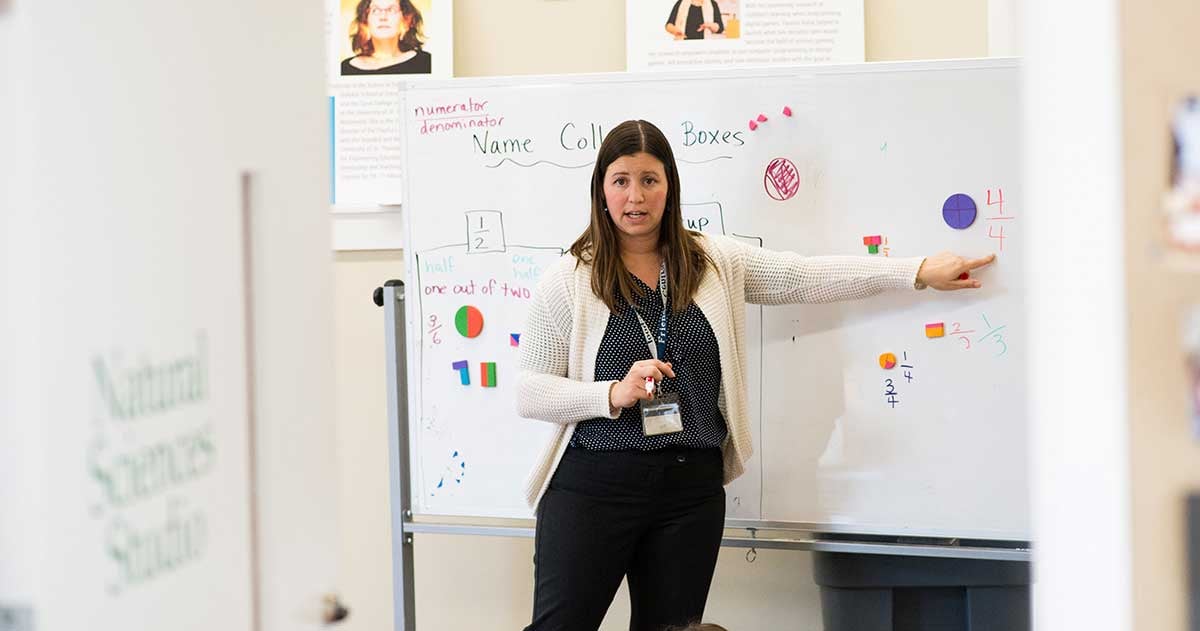
STEM-based learning has been around long enough that most parents and families have at least a vague understanding of what it means: Something to do with science and math. But the truth is, STEM is so much more than that.
What is STEM?
The word STEM stands for Science, Technology, Engineering, and Mathematics, four subjects that are very important for today’s students.
In the traditional school model, each of these subjects is taught independently of the others, with specific classes focused on science, math, etc. in a way that includes relatively little carryover.
Free Downloadable Guide: Take a Closer Look at Friends' Central School
STEM-based education is different because it aims to link these subjects in the minds of students. Because Science, Technology, Engineering, and Math all influence each other, and because the skills and principles learned in one subject very often apply to the others, it makes sense to approach them with an interdisciplinary mindset.
Therefore, a school that is following a STEM-based teaching approach sets up its curriculum so that the lessons in these four areas all complement and reinforce each other.
For example, when students are learning about electricity in science class, they might be learning about circuits in their technology class, building a working robot or gadget (involving circuits) in their engineering class, and practicing algebra in math class.
This learning builds connections between the subjects in the students’ minds while also helping to reinforce their lessons.
What is STEAM?
STEAM is an educational philosophy that evolved out of STEM, where the “A” stands for “Arts”: Science, Technology, Engineering, Art, and Math.
It might seem strange to some people to add the arts in with subjects like science, technology, engineering, and math, but proponents argue that the inclusion of art makes perfect sense.
How so?
Art classes and lessons help students to learn how to think creatively, to develop a mindset of curiosity, and to experiment with new ideas and ways of thinking. Art also introduces the notion of design and aesthetics, two factors that can be critically important in successful projects.
Though art may not directly reinforce or build upon the lessons taught in STEM classes, the subject and the skills that it nurtures does play an important role: It helps students apply their lessons. After all, without creativity and curiosity, what would drive inventors to create new pieces of technology, or to seek new solutions to problems?
Benefits of STEM and STEAM-based Learning
Now that you understand what, exactly, we mean when we talk about STEM and STEAM, we can talk about just why they are so important. To do that, below we explore some of the most important benefits of a STEM or STEAM education.
1. Reinforces lessons from one subject/class in another.
By learning about related subjects in an interdisciplinary way, students are able to apply the lessons that they’ve learned in one class to the problems that they face in another. At its most effective, each subject will reinforce and build upon the lessons taught in the others, allowing students more practice and greater integration of skills than if the classes remained siloed.
For example, math skills are especially reinforced in STEM and STEAM-based curricula, because math is used so often in science, technology, and engineering coursework. Incorporating math into classes besides math helps students to see why math is important, and how it impacts nearly everything that they do. And in the long-term, this increased practice can have a tremendous impact on a student’s ability to perform well in standardized testing such as the SATs or ACT.
2. Helps students see real-world applications of their education.
A common question that teachers hear from students, especially when talking about math, is: Why do I need to learn this? When will I ever use it? How will it impact my life?
They’re fair questions, but ones that teachers can sometimes stumble over when answering.
STEM and STEAM show students how their lessons have real-world applications. By applying math to the fields of technology and science, STEM teaches children that math is important in everything from daily activities to specific jobs; by applying technology to the realm of science and engineering, STEM teaches children that technology is more than just a gadget—it’s a tool that can be used to great effect.
A child learning about electricity in their science class, for example, may struggle to understand why they should care. But by exploring the subject through other classes, the connection becomes obvious. Imagine learning about electricity in science class, reading about how the advent of electricity changed our society in history class, and actually building a working circuit in a tech class.
These are important lessons for children of all ages to learn (and the earlier, the better!). By understanding the real-world applications of their education, a child is more likely to feel as though they have a stake in their education, which can foster a love of learning that will be carried throughout their life.
3. Prepares students for the jobs of the future, which will rely more and more on technology and math skills.
Though most elementary and middle school children aren’t concerned about getting jobs, the fact remains that STEM and STEAM-based learning build skills that today’s children are going to need for the jobs of the future.
According to the World Economic Forum, 65 percent of children entering school right now will ultimately work in a job or career that does not yet exist. And as the Bureau of Labor Statistics shows, most of these new jobs will be related to the fields of STEM: They predict that employment in STEM-based jobs will grow at about 13% for the foreseeable future—far outpacing job growth in general.
4. Increases creativity, curiosity, and critical thinking
Creativity and curiosity may not seem like “skills” in the traditional sense, but they are in fact two of the most important skills for children to learn to develop and use. Curiosity, because it leads children to ask questions that can help them better understand the world around them and the problems that it faces; and creativity, because it allows them to come up with new and unique solutions to those problems.
By approaching STEM subjects in an interdisciplinary way, students are able to apply lessons from one subject to another, which in and of itself requires critical thinking skills. And by also placing value on creativity through the inclusion of the arts, STEAM makes it even more likely that children will enter high school, college, and the workforce with a mindset that values creativity—and that know how to wield it effectively to solve problems.
More than Just Preparing for the Future
Enabling your child to learn about STEM as early as possible in their academic career is an important step towards helping them prepare for the future, both in terms of their future academics and their career paths.
Beyond this, though, STEM and STEAM help your child perform better in the here and now: reinforcing the lessons they learn in one class by practicing them in another, allowing them to see the real-world applications of their schooling, and nurturing their creative and critical thinking skills.



